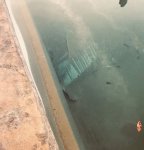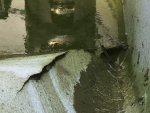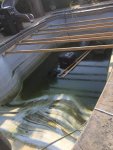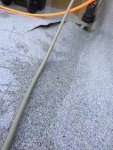Hi everyone! I’m here looking for assistance repairing my pool. Without getting into all the dirty details I’ll give you a short background and what the current issue is.
I had had planned on putting my home on the market this past spring, as I’ve been going through a long dragged out divorce, and can no longer afford my home. When I opened my pool this spring, it had a giant heaved crack in the bottom.
It it is a 13 year old in ground fiberglass, salt water pool.
I’ve gotten several quotes for repairs from pool companies, all of them are outrageous! I am embarking on a DIY project. Through my community I found a woman who had a similar problem but not nearly as severe. She had a friend of a friend (who does fiberglass work on cars) fix her pool 2 years ago, and appeared to hold up. He’s agreed to help me out for half the cost of the pool companies.
Here’s where I am currently at.
1. I have braced the pool.
2. Drained and weighted it with water barrels (to avoid floating)
3. The next step is to make cuts to get it to lay flat. The entire slope is bubbles up. I’ll post pics below, but it’s pretty hard to see in the pics.
4. The pool will need to be painted. I am having a hard time determining what to use - there’s so much conflicting information on the web. I’d rather not have to learn the hard way. It sound like epoxy paint is the way to go with fiberglass, but prices range from reasonable to outrageous. Does more expensive mean better? 2 step coatings better than 1 step coating?
5. It just occurred to me yesterday that I should probably try to find someone to scope the lines while the pool is empty. The lines are still winterized because I obviously didn’t open the pool.
Any help in pointing me in in the right direction is greatly appreciated!
Because of upload limitations the the pictures provided are the beginning of the process. It is currently fully drained and cleaned.
I had had planned on putting my home on the market this past spring, as I’ve been going through a long dragged out divorce, and can no longer afford my home. When I opened my pool this spring, it had a giant heaved crack in the bottom.
It it is a 13 year old in ground fiberglass, salt water pool.
I’ve gotten several quotes for repairs from pool companies, all of them are outrageous! I am embarking on a DIY project. Through my community I found a woman who had a similar problem but not nearly as severe. She had a friend of a friend (who does fiberglass work on cars) fix her pool 2 years ago, and appeared to hold up. He’s agreed to help me out for half the cost of the pool companies.
Here’s where I am currently at.
1. I have braced the pool.
2. Drained and weighted it with water barrels (to avoid floating)
3. The next step is to make cuts to get it to lay flat. The entire slope is bubbles up. I’ll post pics below, but it’s pretty hard to see in the pics.
4. The pool will need to be painted. I am having a hard time determining what to use - there’s so much conflicting information on the web. I’d rather not have to learn the hard way. It sound like epoxy paint is the way to go with fiberglass, but prices range from reasonable to outrageous. Does more expensive mean better? 2 step coatings better than 1 step coating?
5. It just occurred to me yesterday that I should probably try to find someone to scope the lines while the pool is empty. The lines are still winterized because I obviously didn’t open the pool.
Any help in pointing me in in the right direction is greatly appreciated!
Because of upload limitations the the pictures provided are the beginning of the process. It is currently fully drained and cleaned.





 Well, I must say you have quite a chore ahead of you and I commend you for your determination.
Well, I must say you have quite a chore ahead of you and I commend you for your determination. 